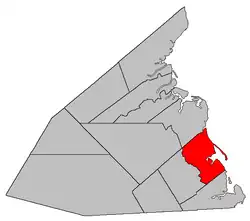Wellington | |
|---|---|
 Saint-Édouard-de-Kent | |
 Location within Kent County, New Brunswick. | |
| Coordinates: 46°31′30″N 64°44′42″W / 46.525°N 64.745°W | |
| Country | |
| Province | |
| County | Kent County |
| Erected | 1814 |
| Area | |
| • Land | 184.80 km2 (71.35 sq mi) |
| Population (2021)[1] | |
| • Total | 3,292 |
| • Density | 17.8/km2 (46/sq mi) |
| • Change 2016-2021 | |
| • Dwellings | 1,747 |
| Time zone | UTC-4 (AST) |
| • Summer (DST) | UTC-3 (ADT) |
| Figures do not include portion within the town of Bouctouche, the Buctouche 16 Indian reserve, and the rural community of Cocagne | |
Wellington is a civil parish in Kent County, New Brunswick, Canada.[4]
For governance purposes it is divided between the towns of Champdoré and Grand-Bouctouche, the village of Five Rivers,[lower-alpha 1] and the incorporated rural community of Beausoleil,[5] all of which are members of the Kent Regional Service Commission,[6] and the Buctouche 16 Indian reserve, which is not.
Prior to the 2023 governance reform, the parish was divided between the town of Bouctouche,[7] the Indian reserve, the incorporated rural community of Cocagne, and the local service districts of Grand Saint-Antoine, Sainte-Anne-de-Kent and the parish of Wellington, which included areas with enhanced services named Bouctouche Cove, Desroches, Dixon Point-Route 134, Wellington - Dixon Point-Route 134, and Saint-Grégoire.[8] Bouctouche and Sainte-Anne-de-Kent became part of Grand-Bouctouche, Grand Saint-Antoine part of Champdoré, Cocagne part of Beaulsoleil, and the LSD of the parish of Wellington was split between all four new municipalities.
Origin of name
The parish was named for the Marquess of Wellington,[lower-alpha 2] British commander in the Peninsular War.[9]
History
Wellington was erected in 1814 as part of Northumberland County from Newcastle Parish.[10] It included modern Dundas and Sainte-Marie Parishes plus most of Saint-Paul Parish.
In 1827 Dundas was erected as its own parish,[11] with the Mahalawodiac River forming the boundary between the two.
In 1828 the boundary with Dundas was altered, moved south to run along grant lines south of Després Road in the east and then straight west.[12]
In 1862 the boundary with Dundas was altered to its modern course.[13]
In 1867 Sainte-Marie was erected from the western part of Wellington, including modern Saint-Paul.[14]
In 1871 the Renauds Mills area was returned from Sainte-Marie.[15]
Boundaries
Wellington Parish is bounded:[2][16][17]
- on the north by the Chockpish River upstream as far as the mouth of the Rivière Chockpish-nord, then south 68º west[lower-alpha 3] to the Sainte-Marie Parish line slightly east of East Branch Road;
- on the east by the Northumberland Strait;
- on the southeast by a line beginning on the shore of Northumberland Strait near Bar-de-Cocagne, then running south 72º 30' west[lower-alpha 4] past Goudalie Road and crossing Renauds Mills Road twice before meeting the Sainte-Marie Parish line east of Saint-Antoine;
- on the west by a line beginning south of Renauds Mills Road, east of Saint-Antoine, then northwesterly straight along grant lines to the Little Buctouche River, then downriver past the prolongation of Chemin Yvon-à-Fred, then northwesterly along to the rear line of a tier of grants straddling Kay Road and across a Crown reserved road that continues Chemin Alban-Légère, then northeasterly along the northwestern side of the Crown reserved road to the eastern line of a grant that runs along part of Dunlop Road, then northwesterly along the grant line to the Buctouche River, then across the river and up Mill Creek to a grant line on the prolongation of Deep Gully Road, then northwesterly along the grant line to Girouardville Road, then southwesterly along Girouardville Road to the southernmost corner of a grant at the corner of Girouardville Road and Mill Creek Road, then northwesterly along the western line of the grant and its prolongation to Mill Creek, then upstream to the eastern line of a grant on the eastern side of Black River Road, then northwesterly along the grant line to Saint-Maurice Road, then southwesterly along Saint-Maurice Road to the western line of a small grant opposite the end of Black River Road, then northwesterly along the grant line and its prolongation to the rear line of grants along the Arsenault Settlement Road, then northeasterly to the western line of a grant that includes the junction of East Branch Road and Arsenault Settlement Road, then north to the northern line of the parish;
- including any islands in front of the parish.
Communities
Communities at least partly within the parish.[16][17][20] bold indicates an incorporated municipality or Indian reserve
|
|
|
|
Bodies of water
Bodies of water[lower-alpha 5] at least partly within the parish.[16][17][20]
|
|
Other notable places
Parks, historic sites, and other noteworthy places at least partly within the parish.[16][17][20]
Demographics
Parish population total does not include Bouctouche, Buctouche 16, and portion within Cocagne (after 2011)
Population
|
LanguageMother tongue (2016)[23]
|
See also
Notes
- ↑ Maps still visible as thumbnails show the current and previous governance boundaries.[5]
- ↑ Wellington was raised to Duke two months after the parish was erected.
- ↑ By the magnet of 1850,[18] when declination in the area was between 21º and 22º west of north.[19]
- ↑ By the magnet of 1862,[13] when declination in the area was between 21º and 22º west of north.[19]
- ↑ Not including brooks, ponds or coves.
References
- 1 2 "Census Profile". Statistics Canada. 26 October 2022. Retrieved 30 October 2022.
- 1 2 "Chapter T-3 Territorial Division Act". Government of New Brunswick. Retrieved 26 February 2023.
- ↑ "Chapter I-13 Interpretation Act". Government of New Brunswick. Retrieved 26 February 2023.
- ↑ The Territorial Division Act[2] divides the province into 152 parishes, the cities of Saint John and Fredericton, and one town of Grand Falls. The Interpretation Act[3] clarifies that parishes include any local government within their borders.
- 1 2 "Kent Regional Service Commission: RSC 6". Government of New Brunswick. Retrieved 26 February 2023.
- ↑ "Regions Regulation – Regional Service Delivery Act". Government of New Brunswick. 21 July 2022. Retrieved 26 February 2023.
- ↑ "Municipalities Order - Municipalities Act". Governmentof New Brunswick. 25 June 2021. Retrieved 26 February 2023.
- ↑ "Local Service Districts Regulation - Municipalities Act". Government of New Brunswick. 25 June 2021. Retrieved 26 February 2023.
- ↑ Ganong, William F. (1896). A Monograph of the Place-Nomenclature of the Province of New Brunswick. Royal Society of Canada. p. 279. Retrieved 17 March 2021.
- ↑ "54 Geo. III c. 17 An Act in further addition to an Act, intituled 'An Act for the better ascertaining and confirming the boundaries of the several Counties, within this Province, and for subdividing them into Towns or Parishes.'". Acts of the General Assembly of His Majesty's Province of New-Brunswick; Passed in the Year 1814. Saint John, New Brunswick: Government of New Brunswick. 1814. pp. 16–18. Retrieved 27 March 2021.
- ↑ "7 Geo. IV c. 31 An Act for the division of the County of Northumberland into three Counties, and to provide for the Government and Representation of the two new Counties.". Acts of the General Assembly of His Majesty's Province of New-Brunswick, Passed in the Year 1827. Fredericton: Government of New Brunswick. 1827. pp. 97–103. Retrieved 27 March 2021.
- ↑ "9 Geo. IV c. 11 An Act to alter the division line between the Parishes of Dundas and Wellington in the County of Kent.". Acts of the General Assembly of His Majesty's Province of New-Brunswick, Passed in the Year 1828. Fredericton: Government of New Brunswick. 1828. p. 17. Retrieved 27 March 2021.
- 1 2 "25 Vic. c. 47 An Act to alter the Division Line of the Parishes of Dundas and Wellington, in the County of Kent.". Acts of the General Assembly of Her Majesty's Province of New Brunswick, Passed in March and April 1862. Fredericton: Government of New Brunswick. 1862. pp. 117–118. Retrieved 27 March 2021.
- ↑ "30 Vic. c. 32 An Act to erect a part of the Parish of Wellington, in the County of Kent, into a separate Town or Parish.". Acts of the General Assembly of Her Majesty's Province of New Brunswick, Passed in the Month of June 1867. Fredericton: Government of New Brunswick. 1867. pp. 56–58. Retrieved 27 March 2021.
- ↑ "34 Vic. c. 14 An Act in amendment of the Act 30th Victoria, Chapter 32, intituled 'An Act to erect part of the Parish of Wellington, in the County of Kent, into a separate Town or Parish.'". Acts of the General Assembly of Her Majesty's Province of New Brunswick. Passed in the Month of May 1871. Fredericton: Government of New Brunswick. 1871. pp. 98–99. Available as a free ebook from Google Books.
- 1 2 3 4 "No. 89". Provincial Archives of New Brunswick. Department of Natural Resources and Energy Development. Retrieved 11 June 2021. Remainder of parish on maps 90, 99, and 100 at same site.
- 1 2 3 4 "269" (PDF). Transportation and Infrastructure. Government of New Brunswick. Retrieved 11 June 2021. Remainder of parish on mapbooks 270, 285, 286, and 302 at same site.
- ↑ "13 Vic. c. 51 An Act to consolidate all the Laws now in force for the division of the Province into Counties, Towns and Parishes.". Acts of the General Assembly of Her Mjaesty's Province of New Brunswick, Passed in the Year 1850. Fredericton: Government of New Brunswick. 1850. pp. 142–152, 145–149. Retrieved 27 March 2021. Book was poorly proofread, resulting in title typo and reuse of page numbers 145–152.
- 1 2 "Historical Magnetic Declination". National Oceanic and Atmospheric Administration. Retrieved 2 March 2021.
- 1 2 3 "Search the Canadian Geographical Names Database (CGNDB)". Government of Canada. Retrieved 6 July 2021.
- ↑ Statistics Canada: 1996, 2001, 2006 census
- ↑ 2011 Statistics Canada Census Profile: Wellington Parish, New Brunswick
- 1 2 "Census Profile, 2016 Census Wellington, Parish [Census subdivision], New Brunswick". Statistics Canada. 8 February 2017. Retrieved 14 September 2019.